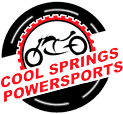Personal Watercraft Riding Tips
Personal Watercraft Riding Tips

Is there any image that so effectively conveys fun and leisure more than the sight of someone ripping around on a personal watercraft? The waves, the spray of water, the speed—it all comes together to create the perfect water experience. But riding a personal watercraft isn’t exactly like riding a motorcycle, nor is it like driving a boat. It takes some practice and some skill to pilot a personal watercraft. So we here at Cool Springs Powersports in Franklin, Tennessee have developed this brief guide to help you learn how to have fun and stay safe on your very own personal watercraft.
Safety First
Safety is key when you’re on a personal watercraft. These devices are so much fun that they can cause you to become complacent about safety practices. But all it takes is a submerged log or a poorly executed turn and you could end up in serious trouble. Make sure to always wear your lifejacket, and follow the local ordinances for the area you’re riding in. Steer clear of other boats, too, and be mindful of all the boat traffic on the water that day. You can’t have fun if you get injured in a serious accident.
Use Your Whole Body
The trick to steering a personal watercraft is to use your whole body. You should really lean into it, throw your weight around, and ride in an active way. You might get enough control by simply sitting down and turning the handlebars back and forth, but at high speeds, you’ll need to take on a much more active stance.
Get to Know Your Personal Watercraft
Every personal watercraft behaves differently. Some have deeper hulls, some have more powerful engines, some turn more quickly. Take a look around your personal watercraft and get to know its performance and safety features. Then, spend some time riding it at low speeds during good riding conditions. Some watercraft make it easier to lean hard into turn for extra grip. Others make leaning into turns a dangerous prospect. Don’t attempt high speed turns and banks before you’re comfortable with the basics of riding your particular personal watercraft.
Use Your Safety Shutoff Lanyard
The safety shutoff lanyard is one of the most important safety features you have on a personal watercraft. This device attaches to the rider’s wrist and a shutoff switch on the personal watercraft. That way, if you get thrown into the water, the engine will immediately shut down. This means you won’t have to worry about the throttle getting stuck and your personal watercraft running off.
Use Throttle When Turning
On a motorcycle, your tires and suspension dictate your turning capabilities. But with a personal watercraft, throttle makes the biggest difference. The best technique for turning is to cut out your throttle just before entering a turn. This will cause the bow to dip down, or “plant,” and it will give you a sort of pivot point around which to turn. Then, you can get back hard on the throttle, which help whip you through and out of the turn.
Follow the Rules of the Waves
It’s important to be conscientious of others when you’re on your personal watercraft. Personal watercraft can make a lot of noise, so consider avoiding riding in the early morning. Don’t spray other riders with water and don’t cut people off through reckless riding. If you need to go past someone or near them, use a horn or whistle to alert them of your presence. A little courteousness goes a long way on the water.
Hopefully this guide gave you a few tips for riding your personal watercraft. If you’re currently in the market for a new personal watercraft, stop by Cool Springs Powersports in Franklin, Tennessee. Our team of passionate watersports enthusiasts will guide you to the right personal watercraft for your needs. If you live near Nashville, Clarksville, Murfreesboro, Dickson, or Hendersonville, Tennessee, not to mention Huntsville, Alabama, stop by today.
